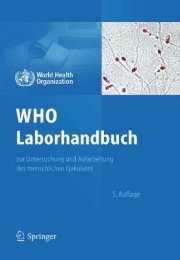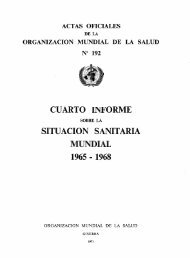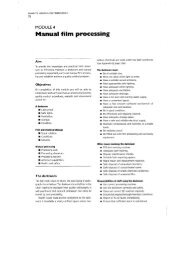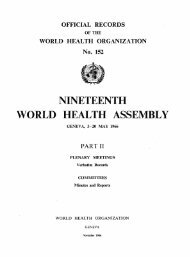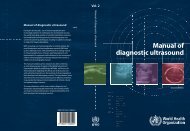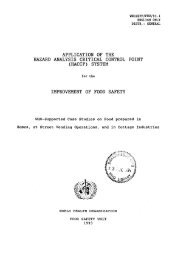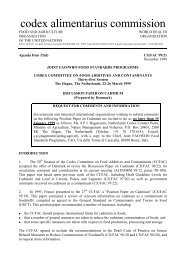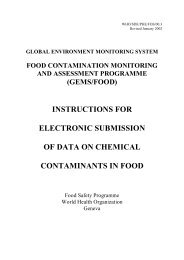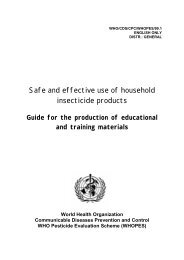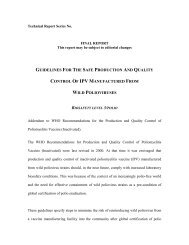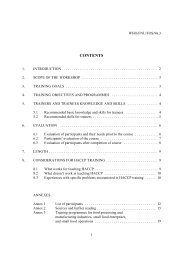WHO Drug Information Vol. 20, No. 4, 2006 - World Health ...
WHO Drug Information Vol. 20, No. 4, 2006 - World Health ...
WHO Drug Information Vol. 20, No. 4, 2006 - World Health ...
Create successful ePaper yourself
Turn your PDF publications into a flip-book with our unique Google optimized e-Paper software.
246<br />
<strong>WHO</strong> <strong>Drug</strong> <strong>Information</strong> <strong>Vol</strong> <strong>20</strong>, <strong>No</strong>. 4, <strong>20</strong>06<br />
Safety and Efficacy Issues<br />
Teratogenicity<br />
of antiepileptic drugs<br />
Prescribing for women with epilepsy is<br />
complicated by the potential teratogenicity<br />
of antiepileptic drugs. Current<br />
guidelines recommend that the most<br />
effective drug should be chosen before<br />
conception and prescribed at its lowest<br />
effective dose, ideally as monotherapy<br />
(1, 2). But which antiepileptic drug is<br />
safest in pregnancy? An editorial in the<br />
British Medical Journal reports on data<br />
now available from pregnancy registries<br />
set up in the late 1990s (3).<br />
To date, the UK Epilepsy and Pregnancy<br />
Registry has recruited more than 3500<br />
women, of whom 72% were given antiepileptic<br />
monotherapy. The overall rate of<br />
major congenital malformation in women<br />
given antiepileptic drugs during pregnancy<br />
was 4.2% compared with 3.5% in<br />
women with epilepsy who were not given<br />
such drugs (4). By three months of age,<br />
infants exposed to sodium valproate<br />
monotherapy during gestation had the<br />
highest frequency of major congenital<br />
malformation (6.2%), confirming similar<br />
findings from an Australian register (5).<br />
Lamotrigine monotherapy was associated<br />
with a 3.2% frequency of malformation,<br />
but in a multivariate analysis this frequency<br />
was not significantly different from<br />
that seen with valproate monotherapy.<br />
The risk with lamotrigine at doses above<br />
<strong>20</strong>0 mg a day was similar to that of<br />
valproate doses of 1000 mg/day. Carbamazepine<br />
was associated with the<br />
lowest frequency of major congenital<br />
malformation (2.2% for monotherapy).<br />
Polytherapy with antiepileptic drugs was<br />
associated with a significantly higher<br />
frequency of major malformation than<br />
monotherapy (6% v 3.7%).<br />
The <strong>No</strong>rth American Pregnancy Registry<br />
found that valproate monotherapy was<br />
associated with a 10.7% frequency of<br />
major congenital malformation. This<br />
represents an increased relative risk of<br />
7.3 compared with a control group from<br />
one US teaching hospital’s malformation<br />
surveillance programme (6). The US<br />
registry had previously reported an<br />
increased risk of malformation in babies<br />
exposed to phenobarbital — an important<br />
finding as this antiepileptic drug is<br />
still widely used in many countries.<br />
The potential for antiepileptic drugs to<br />
cause developmental delay in childhood<br />
is even more difficult to measure than<br />
major congenital malformation. A study<br />
(2) found that valproate monotherapy in<br />
pregnancy was associated with decreased<br />
verbal IQ when compared with<br />
carbamazepine or phenytoin monotherapy,<br />
and that this was dose<br />
related.<br />
It was also reported that 30% of children<br />
exposed to valproate needed special<br />
educational support in school, compared<br />
with 36% of those exposed to monotherapy<br />
with other antiepileptic drugs.<br />
Similar results were reported in a Finnish<br />
study. A further study has, however,<br />
shown adverse neuro-developmental<br />
effects in children exposed to a variety of<br />
antiepileptic drugs during gestation, not<br />
only valproate. The neurodevelopment<br />
effects of antiepileptic drugs (NEAD)<br />
study is currently investigating behavioural<br />
outcomes in children exposed to<br />
antiepileptic drugs in pregnancy<br />
(www.neuro.mcg.edu/np/NEAD.htm).<br />
It remains to be seen whether any of the<br />
newer antiepileptic drugs will prove to be<br />
less teratogenic.



